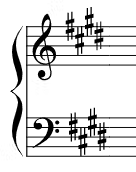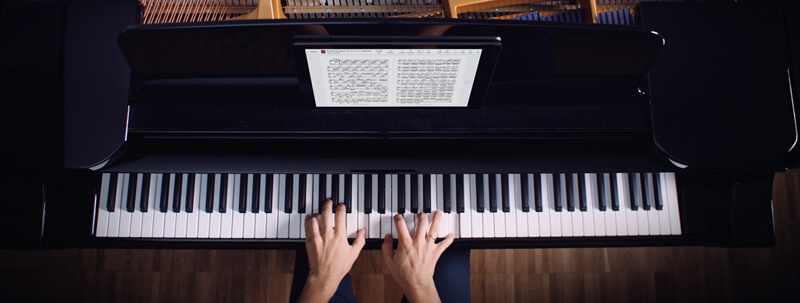C-sharp minor Scale on the Piano - Scales, Chords & Exercises
Jump to section
You get a fascinating chord poster + exclusive content!

The Notes of the C-sharp minor Scale
The C-sharp minor scale starts on C-sharp and includes four sharp notes. It uses the notes C#-D#-E-F#-G#-A-B-C#. On the piano, you need to play four black keys and three white ones.

How to Play the C-sharp minor Scale With the Right Hand (Treble Clef)
On the piano, you can play the C-sharp minor scale going up (toward the higher notes), or coming down. In the treble clef, do this:
- Play the following notes going up: C#-D#-E-F#-G#-A-B-C#. Start playing with your second finger on C# and the third finger on the D#, then tuck your thumb to reach the E. As you continue playing, use your second and third finger, then tuck again to play the A with your thumb, the B with your second finger, and the C# with your third.
- Play the following notes going down: C#-B-A-G#-F#-E-D#-C#. Now just reverse your "climb". Start playing with your third finger on the high C#, and play down to the A, then tuck your third finger over the thumb to play the G#, play down to the thumb and E, and tuck the third finger over once more. Finish on C# with the second finger.

How to Play the C-sharp minor Scale With the Left Hand (Bass Clef)
Piano beginners may find it difficult to read and play the left hand. It is worth investing some time to really familiarize yourself with the notes of the E minor scale in the bass clef, and learn how to read them in music scores.
The notes are the same as in the right hand (C#-D#-E-F#-G#-A-B-C#), but they look different:

How to play C-sharp minor with the left hand
- Going up: Starting with your third finger, play up to the first finger on E, then tuck your third finger to reach the F#. Play up until the first finger reaches the A, then tuck the third finger once more. The second finger finally plays the high C#.
- Coming down: Now reverse what you did on your climb up. Start with your second finger, then play the third. Then tuck the thumb to play the A. Play down to F# and the third finger, then tuck the thumb again to play the E and finish the scale on C#, played with the third finger.
The C-sharp minor Key Signature
The key signature, located at the beginning of each line of a piece, lets you see which notes will be raised (#) or lowered (b) consistently throughout that piece.
If you spot this key signature below, the piece is likely in C-sharp minor (or in its parallel major scale E-Major, you'll be able to determine that from the mood of the piece):

6 Exercises to Practice the C-sharp minor Scale
Play one exercise after the other and only move on after having correctly played the previous exercise 5 times on your piano:
- Play the left hand up and down using a metronome and slowly increasing speed
- Play the right hand up and down using a metronome and slowly increasing speed
- Play both hands up and down using a metronome and slowly increasing speed
- Play the left hand up starting from the lowest C# to the highest, and down starting from the highest C# to the lowest
- Play the right hand up starting from the lowest C# to the highest, and down starting from the highest C# to the lowest
- Play both hands up starting with the left hand on the lowest C# and stopping when the right hand reaches the highest C#, then play down to the starting position
Why you should exercise scales in general:
- To memorize a scale
- To practice agility and intonation (play all keys with even loudness. Beginners often play the notes they work with their stronger fingers much harder. Aim for an even tone)
- To be able to play the scale in time without hesitating to find your fingerings
- To be able to build chords and improvise
C-sharp minor Chords on the Piano
A minor chord is constructed of three or more notes: The root note - the minor third - the perfect fifth.
In short, this means for C-sharp minor:
- The basic C-sharp minor chord consists of C#-E-G#.
- The first inversion is E-G#-C#.
- The second inversion is G#-C#-E.
To practice the C-sharp minor chord and inversions, switch from the chord starting with the root note to the first, and the second inversion, starting slowly using a metronome, then increasing your tempo.
10 melancholy pieces in C-sharp minor
- 1 My Heart Will Go On: James Horner
- 2 Everglow: Coldplay
- 3 Sweet Dreams: Eurythmics
- 4 Vuelvo Al Sur: Astor Piazzolla
- 5 Sonata quasi una Fantasia ("Moonlight Sonata"), Op. 27 No. 2: No. 1 Adagio: Ludwig van Beethoven
- 6 Bad Life: Sigrid, Bring Me the Horizon
- 7 Nocturne C-sharp Minor Op. posth. No. 20: Frédéric Chopin
- 8 Shape Of You: Ed Sheeran
- 9 Isn't She Lovely: Stevie Wonder
- 10 Vladimir's Blues: Max Richter


